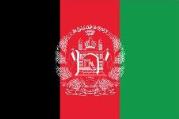Fighting Daesh in Afghanistan
"It's Complicated"
The Battle Against Islamic State in Afghanistan
- and the Blurring Lines that Further Complicate it
Franz J. Marty, Achin District, Nangarhar Province, Afghanistan, 10 February 2018
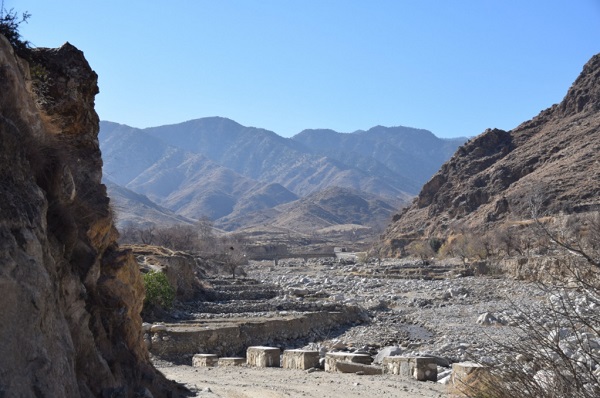
Achin District Nangarhar Province
The quiet scenery – a stone-strewn plain leading to rugged
mountains, the ones close-by small and bleak, the ones on the
horizon rocky massifs capped with snow – betray the battles that
have raged here and are, further up in the mountains, still raging.
Only the many small forts on the way up to the valleys, now flying
Afghan flags, hint at the fact that the district of Achin, located
in the eastern Afghan province of Nangarhar, is the main
battleground between the self-declared Islamic State’s regional
chapter that was
proclaimed in January 2015 and Afghan government
and militia forces supported by their U.S. allies. And while the
unforgiving mountainous terrain is a formidable challenge for all
parties, especially for U.S. forces it is sometimes also hard to
tell their friends from their foes, as there have been occasions in
which alleged or real members of their Afghan allies have turned
their weapons against U.S. soldiers.
Hit, but not Defeated
Since early 2016, the Afghan government has more than once
declared
the defeat of the Islamic State – in Afghanistan referred to by its
derogatory Arabic acronym Daesh – in Achin and other southern parts
of Nangarhar; or asserted that the group is “on the run”. But so
far, the even for local standards zealous extremists always came
back. The harsh mountains play into the hands of guerrilla-like
insurgents. There, Daesh fighters can move back and forth from
valley to valley – on the Afghan side and allegedly also across the
border to Pakistan that runs through the Spin Ghar mountain range.
“It’s like a balloon,” U.S. Army General John W. Nicholson,
commander of U.S. Forces – Afghanistan and the NATO-led coalition,
explained on 28th of November 2017. “We squeeze them in this area
and they’ll try to move out elsewhere.”
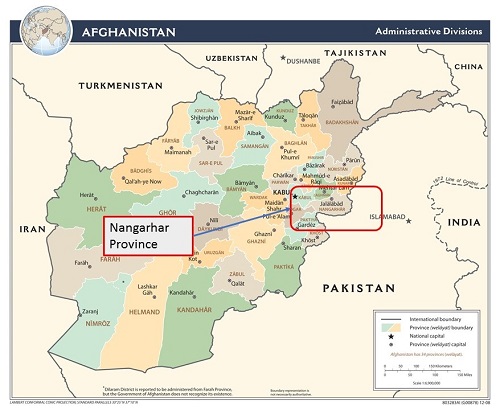
Map of Location of Nangarhar Province (derivedfrom CIA map)
A brief visit to Achin in mid-January showed that joint Afghan-U.S.
efforts have once again pushed Daesh up into the bleak mountains –
well further up than the caves at the entrance to the Momand valley
that the extremists allegedly had used as a stronghold until in
April 2017 - when U.S. forces dropped one of the largest conventional bombs ever built
to obliterate them. During my visit, the drop site sat idly in the
bright sunshine. The scorched trees, burned down where the blaze of
the air blast roared over the ground and into the caves (the used
GBU-43/ B MOAB explodes
above the ground), and some rubble, were the
only reminder of the unprecedented strike.
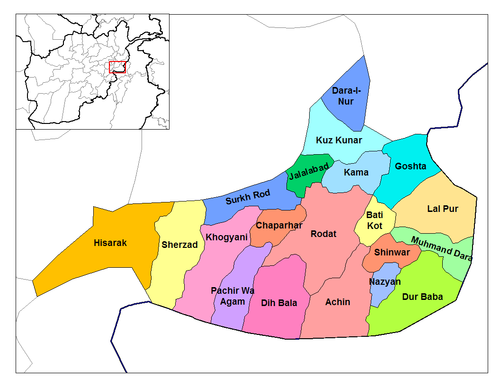
Districts of Nangarhar Province (Wikipedia)
How much further up the militants have been driven, could not be
determined as soon after the drop site a checkpoint manned by
regular Afghan National Army and militia personnel blocked the road.
The Afghan soldier at the checkpoint did not have any exact
information on the situation in the valley. “From here on, there are
only Afghan Commandos, U.S. Special Forces and Daesh fighters,” he
said, and he and his colleagues aren’t told anything about their
operations. At least during the few minutes I had been there, the
valley laid quiet under the snow covered mountain range towering on
the horizon. Unsurprisingly, a radioed request for permission to go
further up was denied.
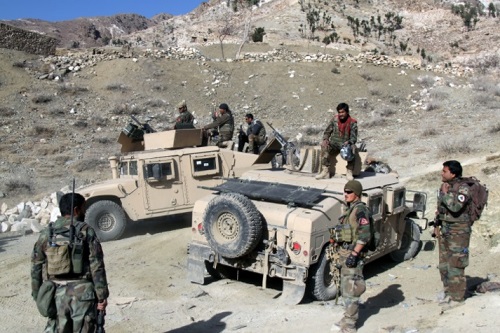
Afghan Commandos prepare to conduct operations in
Momand Valley
(Photo by SPC Jacob Krone, NSOCC-A, Feb 10, 2018)
How the fight against Daesh in Afghanistan is proceeding is not only
here in Achin, but also in general, hard to tell. U.S. officials put
the number of killed Daesh fighters in Afghanistan during 2017 at
about 1,600; the Afghan Ministry of Defence even at around 1,900.
Such numbers are questionable though, as despite such claims U.S.
estimates for still active Daesh
fighters in Afghanistan hover around 1,000 (sometimes a few hundreds
more, sometimes a few hundreds less) since spring 2016. Hence, it
seems more likely that either the numbers of killed or active
Daeshis (or both) are flawed than that Daesh is able to replenish
their forces that fast.
In any event, and despite allegations to the contrary, Daesh has so
far been unable to significantly expand in Afghanistan. While U.S.
Forces – Afghanistan acknowledge minor Daesh pockets in the province
of Kunar, which neighbours Nangarhar (but not Achin), and the far
away northern province of Jowzjan, the nature of the group’s
presences there remain unclear. There is virtually no substantiated
information about Daesh in Kunar available. And although a group in
Jowzjan openly uses Daesh insignias, there are
indications that this
might be more a simple branding with benefits for both – Daesh and
the local group in Jowzjan – than an actual formal and operational
bond. Allegations of a Daesh presence in other provinces are even
more obscure and might well be based on (intentional
or unintentional)
misidentifications or
exaggerations.
Apart from that, Daesh has increasingly claimed responsibility for
deadly terrorist attacks in the capital Kabul. In how far such
attacks are really conducted by the group, cannot be definitively
said though. While there are signs of possible Daesh cells in the
Afghan capital, they are scarce and not clear; similarly, some,
including the Afghan government, assert that other groups (in
particular the Haqqani Network that is seen as an integral part of
the Taliban by most) is behind such attacks, but tellingly fail to
substantiated their allegations.
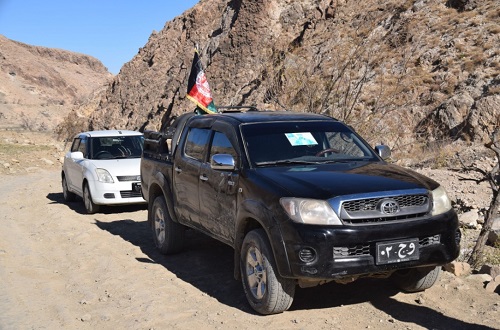
Militia vehicle in the Momand Valley - Nangarhar
province
Friend or Foe?
What makes the fight against Daesh in Achin even worse for U.S.
troops is that they sometimes can’t be sure, who is on their side
and who not, as on some occasions purported allies have opened fire
on them. And while this also happens in areas without Daesh
presence, there are hardly anywhere as many parties (Afghan
government forces, Daesh, pro- government militias and sometimes
also
Taliban) involved as in Achin. Hence, the situation is even
more complicated than in other parts of the country and not always
as clear as official statements suggest, as a recent incident in
Achin’s Momand Valley, that left an Afghan pro- government militia
member dead and a U.S. soldier as well as an interpreter wounded,
shows.
According to U.S. Forces – Afghanistan, on 11th of January “an
insurgent affiliated group posing as local militia (…) baited a
local Afghan militia leader, and a U.S. service member with an
Afghan interpreter into a compound under the pretense of a security
(…) meeting. Upon completion of the meeting, multiple members of the
insurgent group opened fire with small arms weapons at the local
Afghan militia leader.” In retaliation, a U.S. airstrike destroyed
said compound, killing at least 10 alleged insurgents.
The airstrike did not kill everyone though – according to locals,
one eyewitness of the incident survived the bombardment unharmed.
And he contests the U.S. version. (While the eyewitness himself was
not in Achin during this author’s visit and could – despite efforts
– not be reached afterwards, a relative recounted what the witness
had told him.)
According to this account, no insurgents were present in the area
and the militia member killed in the initial shooting was part of
the group that was setting up a post in a vacated compound. The
meeting with U.S. soldiers had been friendly: they drank tea
together, talked about fortifying their post and the U.S. soldiers
promised to repair or replace a broken radio. When the meeting was
over, the U.S. soldiers, the interpreter and a militia member left
the compound in a buggy that U.S. forces use to move around the
difficult terrain. The account of
the eyewitness could not exactly say what happened next, but insists
that someone inside the buggy opened fire. After a few shots that
killed the militia member and wounded the others, the eyewitness
claimed to have offered his help to the wounded, but said that the
U.S. soldiers declined and left. Shortly afterwards, the militia
compound was bombarded.
Both versions raise questions. For example, why would insurgents
posing as militia members risk conducting a meeting, in which the
real militia member accompanying U.S. soldiers might had been able
to expose them, instead of shooting right away? How could several
men who allegedly opened fire on their unaware victims only wound –
but fail to kill – a U.S. soldier and his interpreter? On the other
hand, if it was only an accidental shooting or only the militia
member killed in the shooting had fired, why would the U.S. bombard
the compound afterwards?
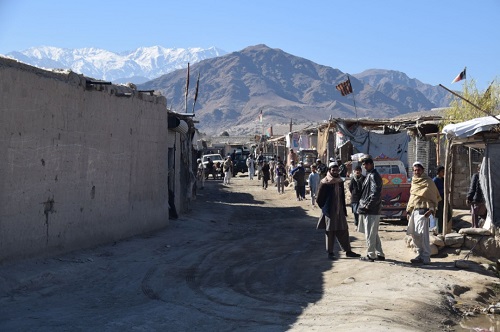
Shadal Bazaar, Achin District, Nangarhar Province
Answering these questions proved impossible. The incident itself took place inside the valley, in an area that was
off limits. And locals in Shadal Bazaar, a nearby settlement that
had been captured by Daesh in the past, but is since months again
under firm government control, couldn’t give any details. This
included the teenage brother of the militia member killed in the
initial shooting, who loitered around the stalls of the bazaar that
sell goods ranging from fresh vegetables to mobile phones and are
topped by myriads of Afghan flags that wave in the clear blue sky.
“The only thing I know is that my brother died as a result of
gunshot wounds to his thigh, but I can’t say what had happened,” he
stated in a low voice. If true, such wounds to only one thigh would
appear inconsistent with the shooting claimed by
U.S. Forces – Afghanistan that declined to address this and other
questions, referring to their original statement.
Locals insist though that at the time of the incident no insurgents
were present in the area – and the fact that in February 2016 people
from the region had
told this author that some militia groups, but
not the one in question, have close ties to the Taliban or are
Taliban themselves, lends credibility to their current statements,
as they acknowledge that the situation is not black and white. This,
paired with earlier instances in which the Taliban have incorrectly
claimed insider attacks, make the Taliban spokesman’s allegation
that also in the incident at hand Taliban insiders had opened fire
unreliable.
This is all the more the case, as the Taliban name the surviving
eyewitness as one of the alleged insiders. However, according to Khair Mohammed, the militia
commander in Achin, said surviving eyewitness was cleared of any
wrongdoing by Haji Zahir Qadir, a member of the Afghan parliament
and overall leader of the militia, and sent back to Achin, where he
is again serving at a militia checkpoint.
Hence, and whatever happened, this either means that an alleged insurgent is again manning
an outpost of a U.S. allied militia or that U.S. forces mistakenly
bombarded such U.S. allied militia members – both prospects are far
from good, but show how blurry the line between friends and foes can
be in Achin. And even without such difficulties, the recent past has
proven that Daesh is more than resilient in its Afghan stronghold in
southern Nangarhar.
Franz
J. Marty is a freelance journalist based in Afghanistan. He writes on a
broad range of topics, but focuses on security and military matters. He
can be followed @franzjmarty (https://twitter.com/franzjmarty)
on twitter.
The
above article has been originally published as a Swedish translation by
Blankspot (https://www.blankspot.se/striden-mot-is-i-afghanistan-blir-allt-mer-komplicerad/).
|
